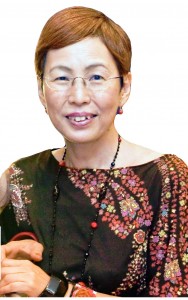Here’s this month’s Kyoto poetry post by our friend Keiji Minato!

Haiku is a well-established poetic form in Japan. Japanese newspapers call for haiku submissions, and a large number of amateur poets send them their works to be chosen for publication by famous masters. There are some TV programs specializing in haiku, for which big events are often held and big auditoriums are filled with hundreds of haiku enthusiasts. You can always find several commercial haiku magazines lined up in the racks of bookstores.
On the other hand, questions remain on what exactly haiku is in the first place. Some regard haiku as typified by those written by old masters like MATSUO Basho (æ¾å°¾èŠè•‰; 1644-1694) and KOBAYASHI Issa (å°æž—一茶; 1763-1827) (Actually, they did not use the term “haiku†for their works, though. They called them “hokku,” meaning the first verse of haikai-no-renga or renku). Others follow the models established in the modernization of the genre since the Meiji era, led by big names such as MASAOKA Shiki (æ£å²¡åè¦; 1867-1902), TAKAHAMA Kyoshi (高浜虚å; 1874-1959), and their countless disciples. Yet another camp says, no, no, our haiku is well beyond old and modern masters, incorporating various influences from Western cultures too. Well, everyone has some say over haiku…
UENO Chizuko (上野åƒé¶´å; b.1948) is famous as a leading feminist critic in Japan; it is not so well-known that she was also a haiku writer under the name Ueno Chidzuko (上野ã¡ã¥ã“). In her book of haiku, Eldorado (黄金郷 [エルドラド]), published in 1990, we can read Ueno’s haiku written during the decade from 1972 to 1982. In the beginning of the preface she writes: “These are haiku. So, this is a book of haiku. To those who say they are not haiku I will say bye-bye.†Her haiku are certainly out of the current orthodoxy of the haiku genre, but the book is also idiosyncratic in that it has a lot of critical essays written by her and her friends/rivals.
She was an active member of a group called Kyodai Haiku Kai (京大俳å¥ä¼š; Kyoto University Haiku Society). Kyodai Haiku Kai is the famous name in the history of haiku. The original group was established in the early 20th century and became famous in the modernist haiku movement called Shinko-haiku (新興俳å¥; New-wave Haiku). It is well-known also because it was wrecked by the arrests of its leading members in 1940: the war-time regime suspected that New-wave haiku writers had relationships with or at least close sentiments with the resistance movements. The group Ueno belonged to had nothing to do with the original Kyodai Haiku Kai, but it is interesting that they both had avant-garde tendencies, and their centers were located in Kyoto. (A new group who called themselves Kyodai Haiku Kai has started up their own activities since 2009. They refer to the original Kyodai Haiku Kai as their predecessors, but seem to show no alliance with the one Ueno belonged to.)
Let me quote several haiku by Ueno Chidzuko:
木ã®å®Ÿè½ã¡ã‚‹æ™‚ã®åœ°ã®ãƒ”アニッシモ
[ Ki no mi ochiru toki no chi no pianissimo ]
when nuts fall from the trees pianissimo on the ground
æµ·ã«å‘ãã‚ã†é€£ç¶¿ã¨æ»ã«ç¶šã‘ã¦ããŸå®¶ç³»
[ Umi ni muki au renmen to shini tsuzukete kita kakei ]
facing the ocean a long and unbroken family line with innumerable deaths
It is clear that Ueno does not follow the 5-7-5 mora (Japanese sound unit) formula. (I tried to capture the rhythm of her haiku by translating them in one line.)
俺ãŒé½§ã£ãŸæ¯å½¢ã‚’ã¤ã‘ã¦æœˆãŒç¼ºã‘
[ Ore ga kajitta hagata o tsukete tsuki ga kake ]
With teeth marks left by me the moon wanes
The narrator of a haiku usually corresponds with the author. Here Ueno uses “Ore†(俺), a first pronoun for a male, which gives a fictional taste to the poem.
çºè¶³ãŒãžã‚ãžã‚地下生活者ã®ä¸Šã‚’
[ Tensoku ga zorozoro chika-seikatsusha no ue wo ]
compressed feet go in succession above underground inhabitants
ホルモン屋ã«ãã‚Œã¦ã‚„る救急外科ã®è£å£ã‹ã‚‰
[ Horumon-ya ni kurete yaru kyukyu-geka no uraguchi kara ]
Give them to an intestine restaurant cook from the backdoor of ER
æ•…éšœã—ãŸåä¾›ãŸã¡åºåœ’ã®èŠ±ã¨ã—ã¦
[ Kosho shita kodomo tachi teien no hana to shite ]
children out of order serve as flowers in the garden
婚礼ã®è·ã«å…¥ã‚Œã‚‹å¼Ÿã®ç¾©è¶³
[ Konrei no ni ni ireru otouto no gisoku ]
Added to the goods for my marriage my brother’s artificial leg
自閉å…ã®å£ç¯€ãƒ¡ãƒãƒ³ã¯ç†Ÿã‚Œã«ã†ã‚Œ
[ Jihei-ji no kisetsu meron wa ure ni ure ]
The season of autistic children melons ripen too much
ã‚ãªãŸã‚’æ„›ã—ã¦ã„る 鉄ã®åŒ‚ã„
[ Anata o aishite iru Tetsu no nioi ]
I am in love with you the smell of iron
Let us go back to the question: what is haiku? Are Ueno’s works I quoted above haiku? Many haiku writers today say no, or give ambiguous answers. Many of her haiku show the grotesquerie of contemporary life explicitly, and even love haiku smell ominously of iron. Most haiku writers tend to avoid such themes and tones as in her works. Reading the high-level criticisms by Ueno herself and her colleagues in Eldorado, besides her haiku themselves, I cannot help imagining another haiku world more thrilling with Ueno as an active participant…
In the preface Ueno also wrote: “All poets have a hidden hope, which is a hope to do without writing poetry, and I seem to have reached that goal,†and she is true to her words. She does not write haiku now.
* Ueno Chidzuko, Eldorado. Shinya-sosho, 1990 (上野ã¡ã¥å 『黄金郷(エルドラド)ã€æ·±å¤œå¢æ›¸, 1990)
**********************************
This text and translations by Keiji Minato. Keiji writes a guest blog for Deep Kyoto once a month introducing Kyoto’s poets and poetry. You can find former articles by Keiji Minato here.
Of Related Interest:
Cities of Green Leaves é’葉ã®éƒ½å¸‚ – Ginko no Kukai
The Hojoki – Visions of a Torn World
Irish Haiku!
One Hundred Poets on Mount Ogura, One Poem Each
Introducing Keiji Minato
Songs and Stories of the Kojiki retold by Yoko Danno
Japan International Poetry Society